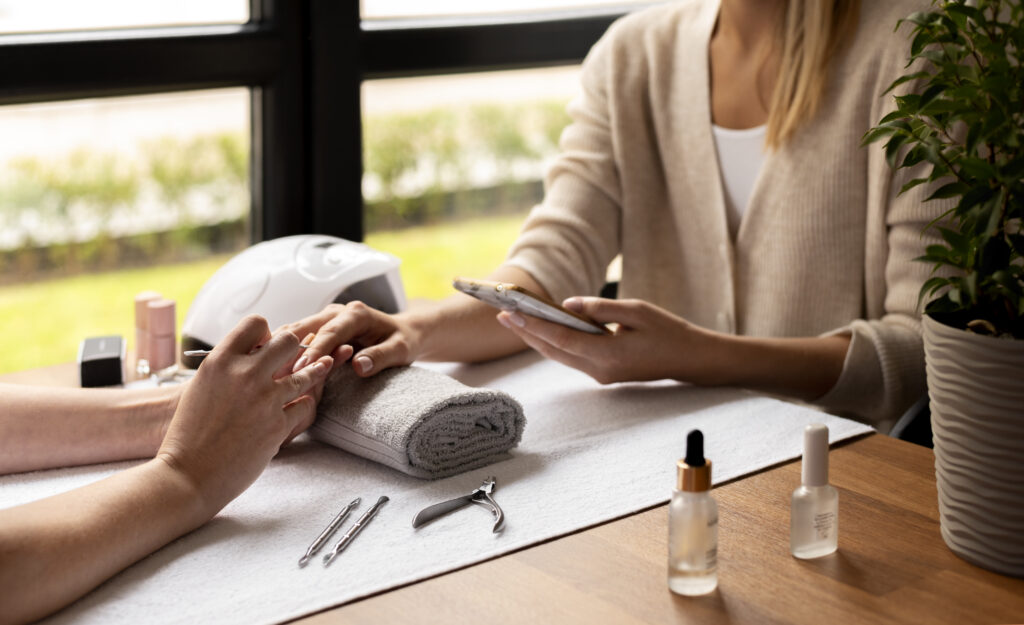Business Planning & Strategy, Financial Models
Nail Salon Business: Costs, Revenue Potential & Profitability
Nail salons operate in a high-frequency, affordable luxury segment of the beauty industry. Demand is stable, repeatable and anchored in grooming routines, social occasions, and wellness consumption. Despite low ticket prices, profitability can be strong when driven by optimized chair utilization, prepaid packages, and disciplined labor management. While most salons rely on volume alone, scalable salons structure for retention, upselling, and service efficiency.
Asset Configuration
CapEx is low-to-moderate, focused on high-density manicure/pedicure stations, ambiance design, and hygiene compliance. A full-service salon typically includes 6–15 stations, a small front desk, and minimal back-of-house. Total space: 800–2,000 sq. ft.
| Asset Category | Cost Range (USD) | Notes |
|---|---|---|
| Manicure & Pedicure Stations | $25,000 – $60,000 | Chairs, foot spas, manicure tables, ventilation systems |
| Reception & Waiting Area | $8,000 – $15,000 | POS, product display, seating |
| Interior Design & Branding | $10,000 – $20,000 | Flooring, lighting, mirrors, color palette |
| Tools & Equipment | $7,000 – $15,000 | Nail dryers, autoclaves, polish storage |
| Booking, POS & CRM Software | $5,000 – $10,000 | Online booking, waitlists, client notes, upsell prompts |
Total CapEx: $55,000 – $120,000, depending on capacity and positioning (budget vs. premium). Modular layouts (manicure tables that convert) further improve ROI per sq. ft.
Revenue Model
Revenue is driven by per-service pricing across manicures, pedicures, gel/acrylic sets, fills, nail art, and add-ons. Standard services range from $20–$80, with premium treatments exceeding $100+. Upsells include art, gel upgrades, repairs, and wellness add-ons (e.g., paraffin, scrubs).
Recurring revenue streams come from membership programs (e.g., 2 gel manis/month @ $85), prepaid packages, and retail products (nail oils, lotions, gift cards). Group events (bridal, corporate) offer high-yield slots during off-peak hours.
Annual Revenue Potential for a 10-Station Urban Nail Salon
| Revenue Stream | Volume Assumption | Annual Revenue (USD) |
|---|---|---|
| Core Services (Mani/Pedi, Gel, etc.) | 16,000/year @ $45 avg. | $720,000 |
| Nail Art & Add-Ons | 6,000/year @ $15 avg. | $90,000 |
| Membership Plans | 250 clients @ $80/month | $240,000 |
| Retail & Aftercare Products | $750/week avg. | $39,000 |
| Group Bookings & Events | 100 events/year @ $300 avg. | $30,000 |
| Total | $1,119,000 |
Top-tier salons with brand equity, Instagram-worthy design, and full technician schedules can exceed $1.3M+. Underoptimized shops with walk-in-only models and low pricing often cap at $200K–$400K.
Operating Costs
Labor (nail technicians and reception) is the main cost driver, typically paid per service or via commission (40–60%). Product costs are moderate but must be tightly managed. Overhead includes rent, laundry, and marketing.
| Cost Category | Annual Cost (USD) |
|---|---|
| Technician Compensation | $450,000 – $560,000 |
| Supplies & Consumables | $90,000 – $110,000 |
| Admin & Front Desk | $70,000 – $90,000 |
| Rent & Utilities | $100,000 – $130,000 |
| Software, Booking, POS | $20,000 – $30,000 |
| Marketing & Customer Retention | $45,000 – $65,000 |
| Total | $775,000 – $985,000 |
Efficient salons with full chair occupancy, strong retail attachment, and prepaid plans achieve 25–30% EBITDA margins. Poorly managed salons reliant on heavy discounting and walk-ins often fall below 15%.
Profitability Strategies
Core KPIs: appointments per station per day (APSD) and add-on capture rate (ACR). Benchmarks: APSD > 6 and ACR > 40%. Implement tiered booking (senior techs, art levels) and optimize shift turnover to maximize daily yield.
Lock in revenue with monthly memberships, prepaid visit bundles (e.g., 6 gel manis @ 15% off), and automatic rebooking. Upsell during service via scripted add-ons (e.g., “Would you like to upgrade to chrome or design today?”).
Automated reminders, cancellation penalties, and loyalty programs reduce no-shows and extend LTV. Aim for retention >60% at 6 months through personalized offers and reactivation campaigns.
Control cost through standardized toolkits, JIT polish inventory, and product usage tracking. Cross-training front desk in retail and upselling further increases service-to-retail conversion.
So what?
A nail salon is not a commodity, it’s a high-frequency, repeatable service business with embedded upsell potential. Profitability depends on chair density, client retention, and monetized loyalty. Operators who structure memberships, manage throughput, and optimize technician utilization can achieve 25–30% EBITDA margins on <$120K CapEx. Nails may be small but the business must be built with precision.

Are you considering opening your Nail Salon business? Download the comprehensive Nail Salon Business Financial Model Template from SHEETS.MARKET to simplify your financial planning. This tool will help you forecast costs, revenue, and potential profits, making securing funding and planning for success for your Nail Salon business easier.



